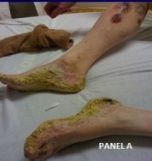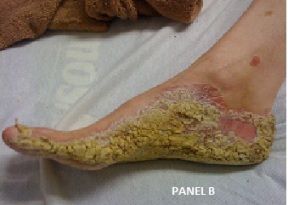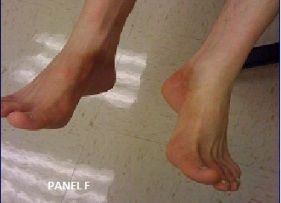- Clinical Technology
- Adult Immunization
- Hepatology
- Pediatric Immunization
- Screening
- Psychiatry
- Allergy
- Women's Health
- Cardiology
- Pediatrics
- Dermatology
- Endocrinology
- Pain Management
- Gastroenterology
- Infectious Disease
- Obesity Medicine
- Rheumatology
- Nephrology
- Neurology
- Pulmonology
Snapshots of Neurosyphilis
A 38-year-old man presented with a 2-week history of mental status changes and impaired memory. He also had a rash on both hands and feet that had been getting worse for the past few months.
A 38-year-old man presented with a 2-week history of mental status changes and impaired memory. He also had a rash on both hands and feet that had been getting worse for the past few months. The rash was initially red and pruritic and then became scaly. He had no other relevant medical history. He did report having unprotected sex with male partners. He was currently employed as a bartender.
In addition to the hyperkeratotic rash on both hands and feet (Panels A and B), there were 3 rounded purpuric lesions below the right knee, and bilateral toe nail onychomycosis (Panel A). Neurologically, the patient was oriented to person and place. He had difficulty with memory testing, specifically naming the current President and the place where he worked. Laboratory findings included a positive rapid plasma reagin (RPR) value of 1:16,384 (normal is negative) which was confirmed by a FTA-ABS test.


The RPR test measures nontreponemal antibodies that are produced when Treponema pallidum interacts with the host tissue. A positive titer may be indicative of syphilis, among other disorders. The RPR test result is usually confirmed with the more specific FTA-ABS test. A CSF-VDRL was positive-another indication of neurosyphillis. Rapid HIV test screening was positive for infection. MRI of the brain revealed an abnormal enhancement in the right anterior thalamo-capsular junction, which was probably consistent with sequelae of infection.
In the hospital, the patient completed most of a 14-day course of IV penicillin G for neurosyphillis and finished treatment at a skilled nursing facility. Follow-up arrangements were made for him to begin treatment for HIV at a specialized clinic. The RPR value at a 3-month follow-up had decreased to 1:256, but the patient’s mental status remained poor. Treatment with penicillin rarely will reverse or ameliorate mental status decline associated with neurosyphillis, but it may decrease the risk of further deterioration. Comorbid HIV infection makes this patient vulnerable to opportunistic infections that can also affect cognition.
Dermatologic findings were almost completely resolved at the 3-month follow-up visit (Panel F). Analysis of skin biopsy specimens taken from the purple lesions on the anterior leg did not reveal any findings consistent with syphilis.

Teaching Points
• Syphilis is a sexually transmitted infection affecting the genital areas and skin and may affect the heart and brain if left untreated.
• Consider neurosyphilis in patients presenting with altered mental status along with risk factors for HIV/syphilis.
• Treatment for neurosyphilis requires timely IV antibiotic treatment with penicillin G.
